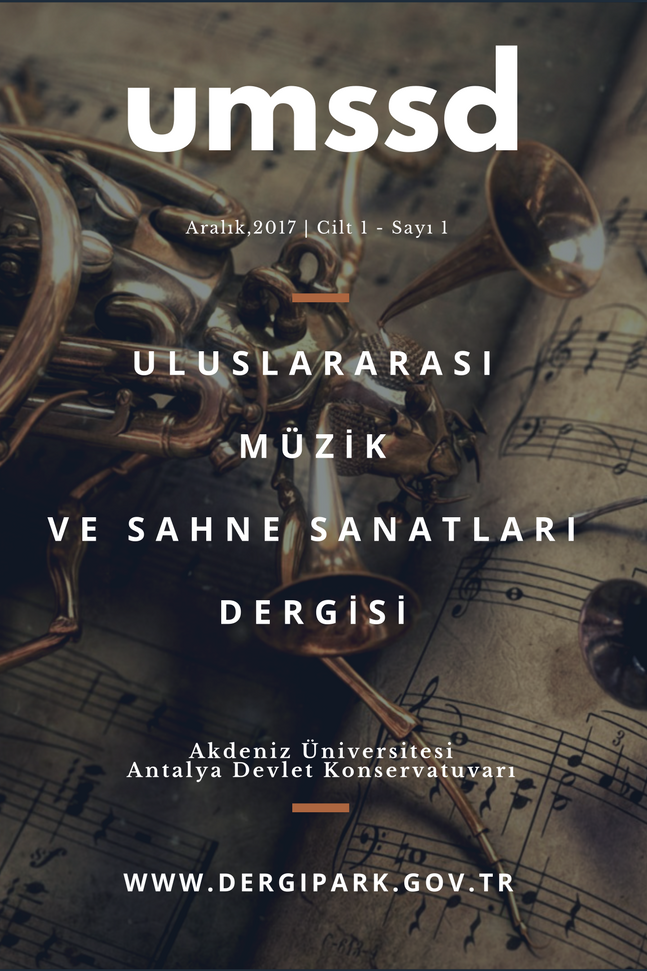KONSERVATUVARLARDA SOLFEJ VE DİKTE DERSLERİ İÇİN ÖRNEK BİR UYGULAMA ÖNERİSİ
İyi bir müzisyen olmanın şartları iyi duyan bir kulak, gördüğünü hemen algılayan bir göz, hassas bir tempo algısı ve keskin bir ritim duygusuna sahip olmaktır. Ancak öğrencilerin bahsedilen şartları yerine getirmesi için müziksel işitme, okuma ve yazma derslerini alması, çalgı dersleri kadar önem teşkil eder.
Yapılan bu çalışma ile müziksel okuma ve yazma derslerinin verimliliğini artırmaya yönelik örnek öğretim ve uygulama yöntemleri anlatılmıştır. Ayrıca doğru bir süreçle hayata geçirilmesi konusunda farkındalık yaratmak amaçlanmıştır. Bu farkındalıkla sanatta üst seviyelere ulaşılması, duyuşu ve okuyuşu refleks haline getirerek, müziği anlamak için sürat kazanılması hedeflenmektedir. Bu çalışmada konservatuvar öğrencileri için başlangıç sınıfları ele alınarak uygulanacak metotlar, süreçler tartışılmış ve kitap önerilerinde bulunulmuştur. Uygulama yöntemlerinin doğru bir şekilde hayata geçirilmesi ile öğrencilerin, müzik sanatı yanında kendini bilme, kendine güvenme, farkındalık, odaklanma, sabır, süreklilik, dikkat gibi konularda gelişeceklerine ve bilinç kazanacaklarına inanılmaktadır.
Sonuç olarak, müziksel okuma ve yazma derslerinin, profesyonel müzik eğitimi alan öğrencilerin sanat yaşamlarına katkısı göz önünde bulundurularak uygulamaların belli bir disiplin ve süreklilik çerçevesinde yapılması gerekliliği ortaya konmaktadır.
A SAMPLE APPLICATION PROPOSAL FOR SOLFEGE AND DICTATION LESSONS IN CONSERVATORIES
The essentials of being a good musician are to have a good hearing ear, an eye that immediately perceives what it sees, a sensitive perception of tempo and a sharp sense of rhythm. However, in order for the students to fulfill the mentioned conditions, taking musical hearing, reading and writing lessons is as important as instrument lessons.
In this study, teaching and application methods are explained in order to increase the efficiency of musical reading and writing lessons. In addition, it is aimed to raise awareness about the implementation of the right process. As a result of this awareness, it is aimed to reach higher levels in art, to make hearing and reading reflexes and to gain speed in order to understand music.
In this study, the methods and processes to be applied for conservatory students were discussed, and book recommendations were made. It is believed that with the correct implementation of the application methods, students will develop and gain consciousness in subjects such as self-knowledge, self-confidence, awareness, focus, patience, continuity, attention, as well as the art of music.
As a result, it is revealed that musical reading and writing lessons should be carried out within the framework of a certain discipline and continuity, taking into account the contribution of students with professional musical education to their artistic lives.
___
- Bach, J. S. (1871), 371 Vierstimmige Chorale, Leipzig: Breitkopf und Hartel.
- Casterede, J. (1985), Les Intervalles, Paris: Edition Salabert.
- Classen, H. (1962), Le Solgefe des Debuttants, Paris: Edition Combre.
- Dandelot, G. (1935), Etude de Rhytme, Paris: Alphonse Leduc.
- Dandelot, G, (1928), Manuel Pratique, Paris: Max Eschig.
- Dannhauser, A. (1981), Solfege des Solfege, USA: Hal Leonard.
- Fenmen, M. (1997), Müzikçinin El Kitabı, Ankara: Müzik Ansiklopedisi Yayınları. Ankara.
- Fontaine, F. (1985), Ritim ve Zaman Duygusunun Temelleri, Paris: Henry Lemoine.
- Gallon, N. (1949), Cous Complete Dictee Musicale, Paris: Editions J. Jobert.
- Gartenlaub, O., Dictees a Parti Manquantes, Paris: Alphonse Leduc.
- Gartenlaub, O., Depistage de Fautes, Paris: Edition Rideau Rouge.
- Karkın, A. M. ve Baş, E. (2016), Başlangıç Solfej ve Dikte Öğretiminde Ezgi Kalıpları Modelinin Uygulanması Örneği, İnönü Üniversitesi Sanat ve Tasarım Dergisi, Malatya.
- Petit, S. (1939), Dictees Musicales, Paris: Alphonse Leduc.
- Pozzoli, E. (2005), Cours Complete de Solfege, Paris: Ricordi.
- Rueff, J. (1968), 250 Dictees Musicales Progressives, Paris: Alphonse Leduc.
- Saygun, A. (1967). Töresel Musiki, Devlet Konservatuvarı Yayınları serisi, Devlet Kitaplari Müdürlügü, Ankara.
- Sun, M. (1991), Solfej, Ankara: Evrensel Müzik evi, Ankara.
- Uçan, A. (1996), İnsan ve Müzik İnsan ve Sanat Eğitimi, Ankara: Müzik Ansiklopedisi Yayınları, Ankara.
- Waignein, A. (2013) Solfege Elementaire, Paris: Schott.
- Yavuzoğlu, N. (2017), Müzik Teorisi, İstanbul: İnkılap Kitabevi.
- ISSN: 2630-5844
- Başlangıç: 2017
- Yayıncı: Akdeniz Üniversitesi
Sayıdaki Diğer Makaleler
AZERBAYCAN’DA İLK NOTALI HALK ÇALGILARI ORKESTRASI
Hamid SULTANOV, Aynur Elhan NAYİR
KONSERVATUVARLARDA SOLFEJ VE DİKTE DERSLERİ İÇİN ÖRNEK BİR UYGULAMA ÖNERİSİ
ISPARTA TÜRKÜLERİNİN EZGİ, RİTİM VE ŞİİR YAPISI BAKIMINDAN İNCELENMESİ
TÜRK ve JAPON NİNNİLERİNİN SÖZEL ve MÜZİKAL ANALİZİ
Çağatay Ege ŞAHİN, Feyzan GÖHER
PANDEMİ SÜRECİNDE YÜKSEKÖĞRETİMDEKİ TİYATRO EĞİTİMİNE DAİR SORULAR/ÖNERİLER: TÜRKİYE ÖRNEĞİ
GYÖRGY LİGETİ’NİN SOLO VİYOLONSEL SONATININ TEKNİK AÇIDAN İNCELENMESİ
